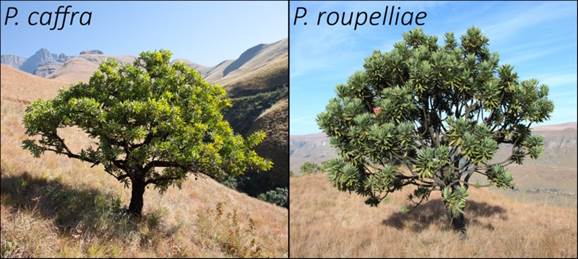Drakensberg fieldtrip report back


Signs of thickening-up of P. caffra on slopes below the Cave Sandstone band (Original image taken by Ulrich Nanni)
Sam Jack (Research Assistant) and Daniel Poultney (BSc Honours student) undertook a 3 week fieldtrip to the Drakensberg in July to retake a large collection of historical photographs from the Injisuthi, Monk’s Cowl and Cathedral Peak areas.
Daniel’s project investigates the abundance and distributional change of two prominent Drakensberg Protea species - namely P. caffra and P. roupelliae - since the initial photographs were taken in the early 1960s. Daniel will also try to determine which environmental variables are most likely to be responsible for any observed changes in Protea abundance through an initial correlational study and subsequent model building exercise.
The historical photographs were taken mainly by the adventurous Ulrich “Ugs” Nanni, who spent much of his working career with the then Forestry Department, during which time he was posted at Cathedral Peak. This is an area he would come to love and revisit frequently for the remainder of his life. Besides maintaining important long term hydrological experiments in the catchments above the Little Berg, NÓnni spent a great deal of time observing and exploring his surroundings, both on and off path, and developed a keen understanding of the ecology of the ‘berg. He also happened to be an avid and skilled photographer, and was meticulous to document where and when he had taken photos. We owe much to Ugs NÓnni for the magnificent photograph collection he left behind.
After hiking through some tough terrain, enduring the winter cold, surviving fire scares and +100 kmph winds, Daniel and Sam returned home with 65 repeated photos and more detailed measurements from 15 selected populations. Sam helped with the matching of the historical and repeat images while Daniel went to work assigning landform units to smaller ‘sub-areas’ within the photos and organising the extraction of a set of biologically relevant environmental variables like rainfall, temperature, fire frequency. etc. With the generous help of James Puttick and Res Altwegg, Daniel was able to show that – contrary to predictions - the number of P. caffra had actually increased in the Drakensberg over time. The increase was greatest at lower elevations and this was thought to be due to higher temperatures and increased atmospheric CO2 concentrations allowing for faster growth and quicker post-burn recovery. Conversely, declines in Protea numbers at higher elevations were ascribed to more intense fires on the more exposed headslopes.

Adult Protea caffra and Protea roupelliae growth-forms (Photo: S. Jack) |
Article by S. Jack
